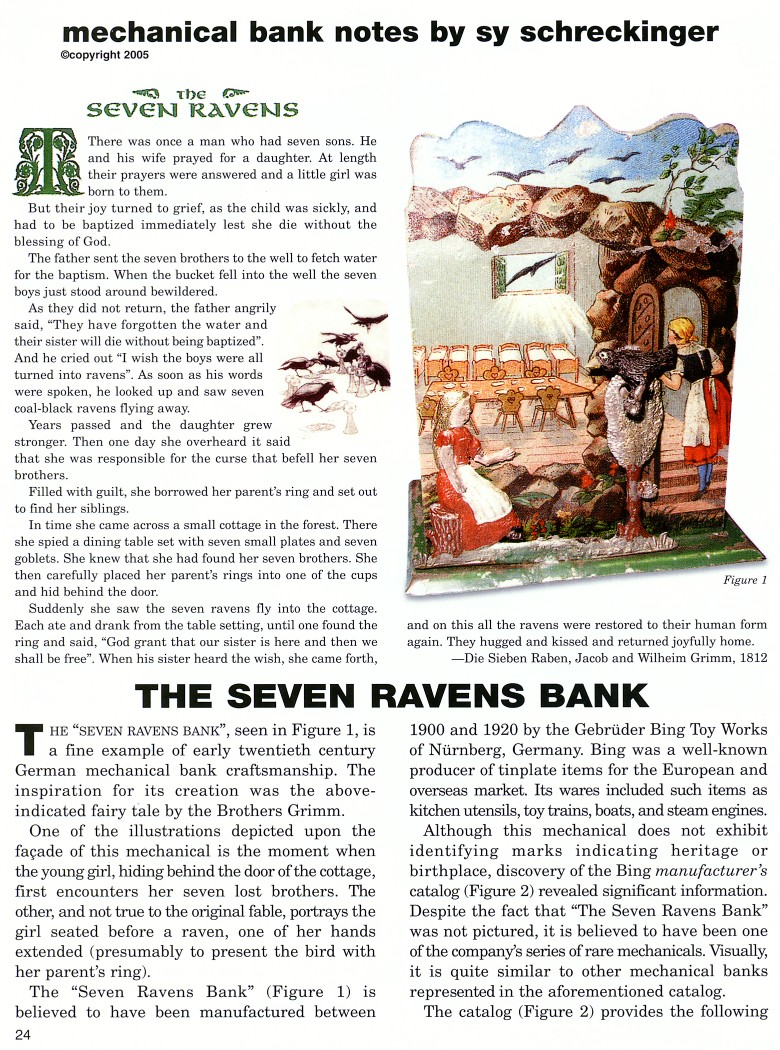|
The Seven Ravens Bank
by Sy Schreckinger ANTIQUE TOY WORLD Magazine January, 2005
The Seven Ravens
There was once a man who had seven sons. He and his wife prayed
for a daughter. At length their prayers were answered and a little girl
was born to them.
But their joy turned to grief, as the child was sickly, and had to be
baptized immediately lest she die without the blessing of God.
The father sent the seven brothers to the well to fetch water for the
baptism. When the bucket fell into the well the seven boys just stood
around bewildered.
As they did not return, the father angrily said, "They have forgotten
the water and their sister will die without being baptized". And he cried
out "I wish the boys were all turned into ravens". As soon as his words
were spoken, he looked up and saw seven coal-black ravens flying away.
Years passed and the daughter grew stronger. Then one day she
overheard it said that she was responsible for the curse that befell her
seven brothers.
Filled with guilt, she borrowed her parent's ring and set out to find
her siblings.
In time she came across a small cottage in the forest. There she
spied a dining table set with seven small plates and seven goblets. She
knew that she had found her seven brothers. She then carefully placed her
parent's rings into one of the cups and hid behind the door.
Suddenly she saw the seven ravens fly into the cottage. Each ate and
drank from the table setting, until one found the ring and said, "God
grant that our sister is here and then we shall be free". When his sister
heard the wish, she came forth, and on this all the ravens were restored
to their human form again. They hugged and kissed and returned joyfully
home.
Die Sieben Raben, Jacob and Wilheim Grimm, 1812
The "Seven Ravens Bank", seen in Figure 1, is a fine example
of early twentieth century German mechanical bank craftsmanship. The
inspiration for its creation was the above-indicated fairy tale by the
Brothers Grimm.
One of the illustrations depicted upon the facade of this mechanical
is the moment when the young girl, hiding behind the door of the cottage,
first encounters her seven lost brothers. The other, and not true to the
original fable, portrays the girl seated before a raven, one of her hands
extended (presumably to present the bird with her parent's ring).
The "Seven Ravens Bank" (Figure 1) is believed to have been
manufactured between 1900 and 1920 by the Gebruder Bing Toy Works of
Nurnberg, Germany. Bing was a well-known producer of tinplate items for
the European and overseas market. Its wares included such items as kitchen
utensils, toy trains, boats, and steam engines.
Although this mechanical does not exhibit identifying marks
indicating heritage or birthplace, discovery of the Bing manufacturer's
catalog (Figure 2) revealed significant information. Despite the fact that
"The Seven Ravens Bank" was not pictured, it is believed to have been one
of the company's series of rare mechanicals. Visually, it is quite similar
to other mechanical banks represented in the aforementioned catalog.
The catalog (Figure 2) provides the following descriptions and cost
for the Bing series of mechanicals: "Banks Made of tin, nicely decorated.
With good lock and moving figures. Supplied in 24 assorted subjects. Price
per piece: Mark .57".
Figure 3 illustrates an early, circa 1908, Maienthau and Wolff of
Nurnberg, Germany, toy distributor catalog. In it is also pictured a
series of mechanical banks similar in design and construction to the
"Seven Ravens." The description and prices of the Maienthau and Wolff
series of mechanicals are as follows: "Tin Banks, With Movable Figures, in
6 various subjects. Delicately Painted, Hand finished with good lock".
Fractional Mark -.76" Comparison of both catalogs lends insight into the
profit margin for Bing and pricing structure for Maienthau and Wolff.
The "Seven Ravens Bank" was constructed almost entirely of tinplate.
The articulated figures of the raven and little girl are composed of zinc
alloy. Both figures were attractively hand painted. The background
scenery, that of the cottage, was executed upon a thin sheet of polychrome
photolithographic paper affixed to the bank's tinplate facade.
Operation of "The Seven Ravens Bank" is initiated by insertion of a
coin through the slot in the back of the bank. The raven then tilts
forward as if to peck at the outstretched hand of his sister (Figure 4).
Deposits are recovered by opening the key lock, trap door type, coin
retainer located underneath the base of the bank.
It is miraculous that this mechanical, as well as any others in the
Bing group, have survived. In addition to their fragile tinplate
construction, delicate paper-clad and painted surfaces, they were
subjected to the harsh elements and careless youthful ownership.
I am not aware of any reproduced mechanicals in the Bing series.
However, there is the possibility of reproduced parts. In this instance,
limited professional restoration may be considered acceptable without
significantly devaluing the item.
Measurement of "The Seven Ravens Bank" is as follows: Height: 4-15/16
inches; Width: 3-1/2 inches; Depth: 2-3/8 inches. Its diminutive size does
not diminish its desirability. It is an extremely rare, colorful, and
welcome addition to a mechanical bank collection.
Acknowledgements: The superb example of "The Seven Ravens Bank"
(Figure 1) is nested within the Kidd Toy Museum, Portland, Oregon, Frank
and Joyce Kidd Proprietors.
Fellow collectors Harold and Uli Merklein of Nurnberg, Germany,
graciously provided copies of the Bing and Maienthau and Wolff catalog
pages, Figures 2 and 3.
My gratitude to Ms. Mary Beth Dunhouse, Coordinator of Special
Projects and Collections, Boston Public Library, for her research and
provision of information linking the mechanical hank featured in this
article to the "The Seven Ravens" fairy tale.
|

